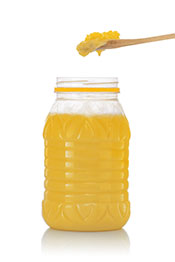 Ghee is a traditional cooking fat similar to clarified butter, and it has been around for thousands of years.
Ghee is a traditional cooking fat similar to clarified butter, and it has been around for thousands of years.
Especially prevalent in South Asian cuisine, it is made by removing the milk solids and water from regular butter.
This article looks at the differences between ghee and butter regarding nutritional composition, taste, and health benefits.
The aim is to answer one question; which is the healthier choice?
What is the Difference Between Ghee and Butter?
The most significant difference between ghee and butter is that the former is 100% pure butterfat.
This contrast is due to a natural heating process that separates the fat in butter.
During this procedure, the water content evaporates, and we can skim the milk solids out of the liquid.
Following this process, only the pure butterfat—ghee—is left.
It is a deep yellow color and looks like this;
See this full guide to ghee for more information.
Nutrition Facts
Below is a comparison of the typical nutritional profile of both fats per 100g (1, 2);
| Nutrient | Butter | Ghee |
| Calories | 717 | 900 |
| Carbohydrate | 0.1 | 0 |
| Fat | 81.1 | 100 |
| Protein | 0.9 | 0 |
As shown in the table, compared to butter, ghee has more calories and fat and contains zero carbohydrates or protein.
The total calories in butter are also much lower due to the water content (approx 17%) which is not present in ghee.
The micronutrient profiles of both fats are almost identical, and both contain beneficial fat-soluble nutrients such as conjugated linoleic acid (CLA), vitamin A and vitamin K2.
The only (very slight) difference is that ghee has a marginally higher amount of vitamins and minerals.
This is because it is a more concentrated source of butterfat.
Smoke Point
As ghee doesn’t contain heat-sensitive milk sugars or proteins, it is much less likely to burn than butter.
Due to being pure (mainly saturated) butterfat, it also has a higher smoke point;
As a result, ghee is much better suited to deep frying than butter.
Allergies

Lactose is a dairy sugar, and it exists in foods like milk, cheese, and butter.
Although butter only has a minimal amount of lactose compared to milk, it is enough to cause symptoms.
On the positive side, the ghee production process fully removes this lactose.
There is also the small matter of casein; a dairy protein that many people are allergic or sensitive to.
While butter is less than 1% protein by weight, even trace amounts of casein can cause problems in those with an allergy.
As ghee is pure butterfat, it contains no casein.
Taste
Comparing these two fats in the flavor department isn’t easy.
In truth, both fats impart a delicious taste in food.
Although ghee has a ‘buttery’ taste, it tastes less creamy than butter, and it’s easy to realize the milk proteins aren’t present.
Ghee has a mildly nutty taste, and it is deeper and richer than butter.
Which of these two tastes people prefer goes down to individual preference.
Personally, I would probably say ghee is the better tasting… but I love the taste of butter too.
It’s a difficult choice!
Storage
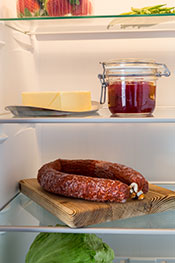
Ideally, butter should be kept in the refrigerator as it can only last a few weeks at room temperature.
However, as ghee no longer contains water or milk solids, it is much more shelf-stable.
As a result, it can be stored in a kitchen cabinet for several months and doesn’t need refrigeration.
Although this doesn’t matter too much logically, the main benefit is that room temperature butter/ghee is easier to spread.
Price
Another important consideration is how much both dairy fats cost.
A quick search on Amazon shows prices of approximately $20 for one pound (454g) of ghee.
If you shop around, then you can likely find it for cheaper, but it’s still a lot more expensive than butter.
I love ghee, but there’s no question it’s overly expensive for what you get.
For example, if you have some butter then it’s so simple to make your own at home and it only takes 15 minutes.
Is that worth the price retailers charge?
Is Ghee Healthier Than Butter?
Now we know the major differences, but what about their effect on our health?
There are claims that ghee (and not butter) contains oxidized cholesterol, and others say that only butter raises our LDL cholesterol.
Is this true?
And does it matter?
Ghee and Oxidized Cholesterol
Ghee has been found to contain cholesterol oxidation products (COP), which are detrimental to heart health and may promote cardiovascular disease (6).
However, this doesn’t automatically make it bad for us.
For one thing, there isn’t lots of research in this area, but the study where many of these claims come from re-heated ghee several times over different days (7).
It’s common knowledge that re-heating cooking fats over and over causes them to break down.
Another key point is that the ghee did contain “a small amount” of COP even before it was first heated.
But again, many things can cause the oxidation of cholesterol. Heating butter at extreme temperatures will cause oxidation products to form – as will poor storage, and exposure to excessive heat and light.
Ghee and Heart Health

“Vegetable ghee” is otherwise known as Vanaspati, which is an industrial fat that contains up to 50% trans fats (8).
Fortunately, studies that separate the two exist, and they show that cardiovascular disease prevalence goes up in groups who use animal ghee and vegetable ghee.
However, in people consuming only animal ghee, there is a lower risk of cardiovascular disease (9, 10).
Furthermore, data shows that the epidemic of cardiovascular disease in India started a few decades ago when traditional fats like ghee were replaced by omega-6 oils and vegetable fats (11).
Does Butter Raise LDL Cholesterol More Than Ghee?
Some view ghee as a healthier choice than regular butter.
Why?
Because, according to research, regular butter can raise our LDL cholesterol levels more than ghee can.
- Consuming ghee as 10% of daily calories results in significant increases in HDL without considerably increasing LDL or triglyceride levels (12).
- In one study, 47 healthy participants added 16.6 grams of butter to their daily diet for five weeks. The result was an average increase in LDL cholesterol of 5.6% and a similar increase in HDL (13).
- Another study fed ghee and butter to rats in a human equivalent dose of 40 grams per 70kg bodyweight. Although both butter and ghee groups experienced increases in HDL and LDL, the rise in LDL levels was much higher in the butter group (14).
In short, larger doses of butter and ghee seem to affect cholesterol profiles to a greater extent.
However, if you are using both as a condiment in reasonably sized portions—as they should be—then any large change in lipid levels is unlikely.
For anyone with concerns over cooking fats and LDL levels, here are some cooking oils that don’t tend to raise LDL levels:
How To Make Ghee From Butter
As mentioned earlier, it is possible to make homemade ghee in approximately 15 minutes.
Should you wish to give it a try, here are some instructions on how to make it.
Step 1 – Prepare Equipment
First of all, you will need the following equipment;
- Glass Jar
- Saucepan
- Cheesecloth
- Sieve
- Large Bowl
Step 2 – Melt the Butter
- Take a stick (or two!) of butter and chop it into small pieces, so that it will melt quicker and more efficiently.
- Next, add the pieces of butter into a pan on medium heat.
- Stir occasionally and move the butter around to keep it from burning until it becomes fully liquefied.
Step 3 – Simmer
- After a few minutes, you will start to notice the surface bubbling and then foaming. Reduce the heat and simmer on a low temperature.
- At this stage, leave it to simmer and carefully watch the butter. Slowly, the foam on top will dissipate.
- You will start to notice milk solids separating from the butter and raising to the top of the liquid and sticking to the sides.
- Knock these milk solids (they are a reddish-brown color) from the sides and occasionally stir to stop them from burning. Keep the butter simmering until you see it start to foam for the second time.
 Step 4 – Butter Becomes Ghee
Step 4 – Butter Becomes Ghee
- Once the butter begins foaming again, take the saucepan off the heat.
- Line the inside of the sieve with the cheesecloth and hold it over your bowl.
- Pour the contents of the saucepan into the sieve and the pure butterfat—ghee—will strain right through into the bowl. However, the strainer will catch the milk solids.
- You will now have a bowl of liquefied ghee – it has a brilliant bright golden color deserving of its nickname ‘liquid gold’.
- Move the mixture into your jar(s) and leave to cool at room temperature until it slowly hardens.
Tip: Adding some herbs at this stage will infuse their flavor into the ghee. Some popular options include garlic, sage, thyme, and rosemary.
Where to Buy Ghee
If you prefer to buy the finished version, then you can buy it from most grocery stores and supermarkets.
Although it is also available from specialist health stores, you can expect to pay a premium.
You can also buy a huge range of ghee products online.
Final Thoughts
Butter versus ghee is a fairly even contest with no clear winner.
As a result, we have to consider which of these two dairy fats suit our personal preferences.
Which has better taste? Are there any issues with lactose or casein? Is cost an issue?
Weigh up the pros and cons and go with whichever one has the edge.


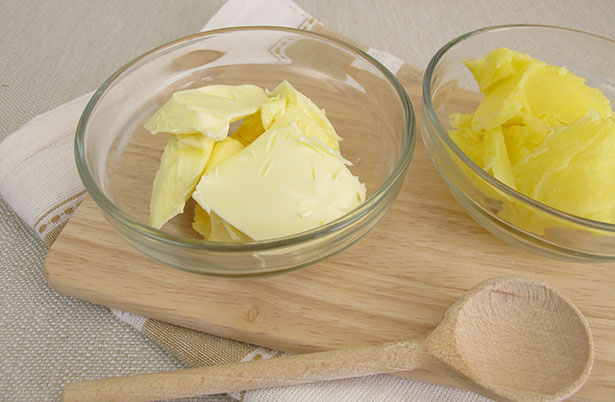
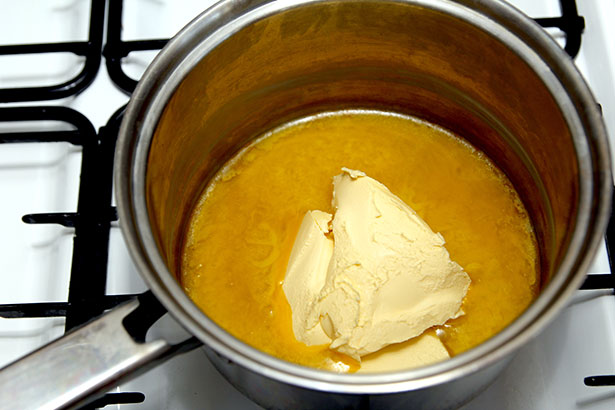
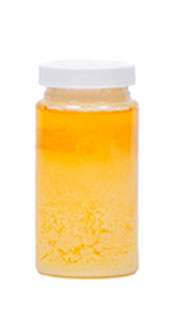 Step 4 – Butter Becomes Ghee
Step 4 – Butter Becomes Ghee
wow, i haven’t seen some thing like butter becoming ghee, thanks for sharing this unique recipe of ghee.
Quite straightforward isn’t it!